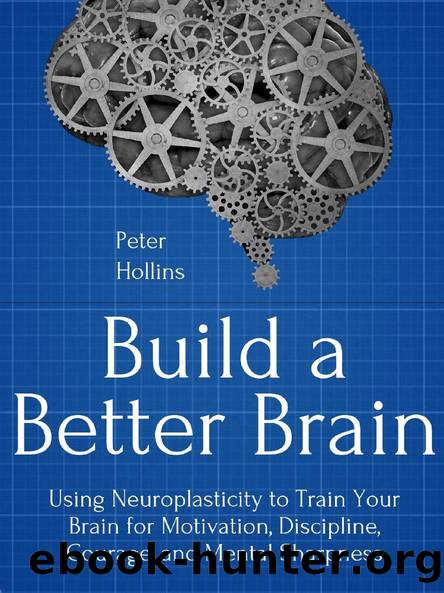Build a Better Brain by Peter Hollins

Author:Peter Hollins
Language: eng
Format: epub
Publisher: PublishDrive
Chapter 4. The Neuroscience of Yes and No
So far, weâve discussed changing your brain in terms of structural and functional plasticityâthe science behind creating and strengthening neural connections and taking over parts of the brain that arenât being used in the cortical remapping manner, respectively. Both cases create real, physical change inside the brain. Weâve mostly discussed structural plasticity because thatâs what we can seek to influence on a daily basis. Structural neuroplasticity underlies our learning, habits, and patterns of behavior.
This chapter takes a slightly different approach to changing and molding the brain for good, as we delve a bit deeper into other agents of neural change, notably neurotransmitters, the chemical substances that dictate our feelings and thoughts, versus the actual physical structures of the brain.
It is a slight distinction, but they are virtually incapable of being discussed separately as they both create the same end result of patterns of behavior that are hard to create and also hard to break out of.
You could also argue that this chapter still addresses structural neuroplasticity because neural changes all have some physical basis, and the fact that some neurotransmitters are produced more than others is a reflection of those neural grooves that have been created over time. Here, they have produced strengthened neurotransmitter pathways and increased or dulled the sensitivity of corresponding receptors. There has been a neural groove worn to inhibit or encourage these chemicals.
In the case of this chapter, we are focusing on the neuroplasticity that dictates our âyesâ and ânoâ responses. The yes response is something that we want to empower and strengthen, as itâs what tells us that âYes, we canâ achieve and do. This is related to self-discipline, motivation, and defeating procrastination. Thus, the neurotransmitters of âyesâ are the ones that we rely on to spark us into action; we want more of them because they allow us to translate our intentions into action.
Manipulating the neuroplasticity of yes is how you can go to the gym even when youâre exhausted and itâs raining outside. Itâs the feeling that you can delay gratification and exercise willpower to accomplish a greater goal. These feelings are made possible, if not driven by, the neuroscience of yes.
On the other hand, the no response is something that holds us back from what we want. This is related to anxiety and fear and the instinctual desire for safety. Thus, the neurotransmitters of ânoâ are set up to stop us from taking action, preferring a lack of motion or even retreat. This keeps us from our goals, and we generally want to overcome them and minimize their production.
The neuroplasticity of no is what keeps you from raising your hand in class or is the feeling in the pit of your stomach before you step onto a stage to speak to five hundred people. These are irrational feelings of stress and fear, and they ultimately hold you back from your best intentions. The neuroscience of no comes from our evolutionary drive for survival and safety, without regard to the reality of situations.
Download
This site does not store any files on its server. We only index and link to content provided by other sites. Please contact the content providers to delete copyright contents if any and email us, we'll remove relevant links or contents immediately.
| Behaviorism | Cognitive Behavioral Therapy |
| Existential | Gestalt |
| Humanistic | Jungian |
| Psychoanalysis | Transpersonal |
The Art of Thinking Clearly by Rolf Dobelli(10329)
The 5 Love Languages: The Secret to Love That Lasts by Gary Chapman(9708)
Mindhunter: Inside the FBI's Elite Serial Crime Unit by John E. Douglas & Mark Olshaker(9266)
Becoming Supernatural by Dr. Joe Dispenza(8171)
Nudge - Improving Decisions about Health, Wealth, and Happiness by Thaler Sunstein(7662)
The Road Less Traveled by M. Scott Peck(7559)
Mastermind: How to Think Like Sherlock Holmes by Maria Konnikova(7281)
Enlightenment Now: The Case for Reason, Science, Humanism, and Progress by Steven Pinker(7274)
Win Bigly by Scott Adams(7142)
The Way of Zen by Alan W. Watts(6557)
Factfulness: Ten Reasons We're Wrong About the World – and Why Things Are Better Than You Think by Hans Rosling(4715)
The State of Affairs by Esther Perel(4692)
Gerald's Game by Stephen King(4612)
Man's Search for Meaning by Viktor Frankl(4507)
The Confidence Code by Katty Kay(4222)
Thinking in Bets by Annie Duke(4186)
The Healing Self by Deepak Chopra(3530)
Hidden Persuasion: 33 psychological influence techniques in advertising by Marc Andrews & Matthijs van Leeuwen & Rick van Baaren(3522)
The Worm at the Core by Sheldon Solomon(3456)
